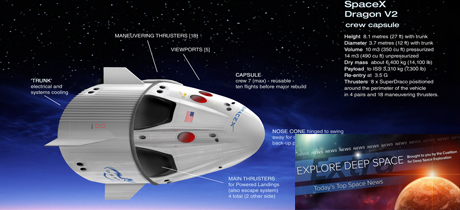In Today’s Deep Space Extra… NASA’s Commercial Crew Program lists delays in SpaceX piloted and unpiloted test flights planned for 2018. NASA’s Kennedy Space Center hosted a tribute to John Young, the Apollo era astronaut who died January 5, on Thursday. NASA’s Mars Reconnaissance Orbiter finds evidence of ice deposits, a potential resource for future human explorers, on the Red Planet.
Human Space Flight
SpaceX delays commercial crew test flights to latter half of 2018
Space News (1/11): SpaceX has delayed its two commercial crew test flights by four months, according to a new NASA schedule released January 11.
Mr. Astronaut’ John Young remembered as American hero
Florida Today (1/11): Astronauts gathered at NASA’s Kennedy Space Center Visitors Complex with others on Thursday to pay tribute to John Young, the Gemini, Apollo and shuttle-era astronaut who died January 5 of complications from pneumonia. Young was an Orlando, Florida, native and among 12 Apollo era astronauts to walk on the moon as commander of Apollo 16.
Space Science
Sheets of ice found below Mars’ surface could be a boon for human exploration
Mashable (1/11): Imagery from NASA’s Mars Reconnaissance Orbiter has unveiled shallow ice deposits on eight sloped regions of Mars. The source may be long ago deposits from snow fall in both the north and southern latitudes of the red planet. “In many ways, water is the key resource: Humans need liquid water biologically, water can be processed to provide oxygen for breathing and hydrogen for energy generation and even rocket fuel. Water ice deposits may be that resource,” Richard Zurek, the chief Mars scientist at NASA’s Jet Propulsion Laboratory, told the publication in an email. Findings were published in the journal Science.
A hyperactive blue comet is approaching the sun
Spaceweather.com (1/11): Lurking beyond Mars is the comet PanSTARRS, whose erratic behavior is fascinating astronomers. No ordinary comet, PanSTARRS is changing day to day. Dusty clouds billow down its tail. Gaseous jets wave wildly around the core. The cause may be an abundance of the volatile material, carbon monoxide.
NASA renames Swift mission after astronomer Neil Gehrels
Space News (1/11): NASA’s Swift astronomy mission, launched in 2004, has been renamed for its late principal investigator, Neil Gehrels, who died in February 2017. The current principal investigator said the spacecraft, which studies galactic high energy events, continues to perform well.
Other News
Pentagon shuts down questions about Zuma, and raises more questions
Space News (1/11): On Thursday, the Pentagon referred questions about the fate of the mysterious Zuma mission launched Sunday from Cape Canaveral Air Force Station, Florida, on Sunday to SpaceX, the launch services provider.
Virgin Galactic SpaceShipTwo hits Mach 0.9 in latest glide test
Popular Mechanics (1/11): Virgin Galactic’s piloted SpaceShipTwo glided to a runway landing in Mojave, California, early Thursday after being dropped from its mother ship, the WhiteKnightTwo, at an altitude of 50,000 feet. The seventh in a series of such flight tests may have set the stage for the vehicle’s first rocket powered flight. Aboard were test pilots Mark Stucky and Michael Masucci.
ISRO’s 42nd PSLV successfully puts 31 satellites in orbit
The Hindu (1/12): India’s Polar Satellite Launch Vehicle deployed satellites across two orbits on Friday. The primary payload, a remote sensing satellite, was accompanied by 30 small satellites as it rose from the Satish Dhawan Space Center, 28 of them from other countries.
China sends twin BeiDou-3 navigation satellites into space
Xinhuanet of China (1/12): With a single launch, China placed two BeiDou-3 global navigation system satellites in orbit on Friday, the 26th and 27th spacecraft in the constellation.

